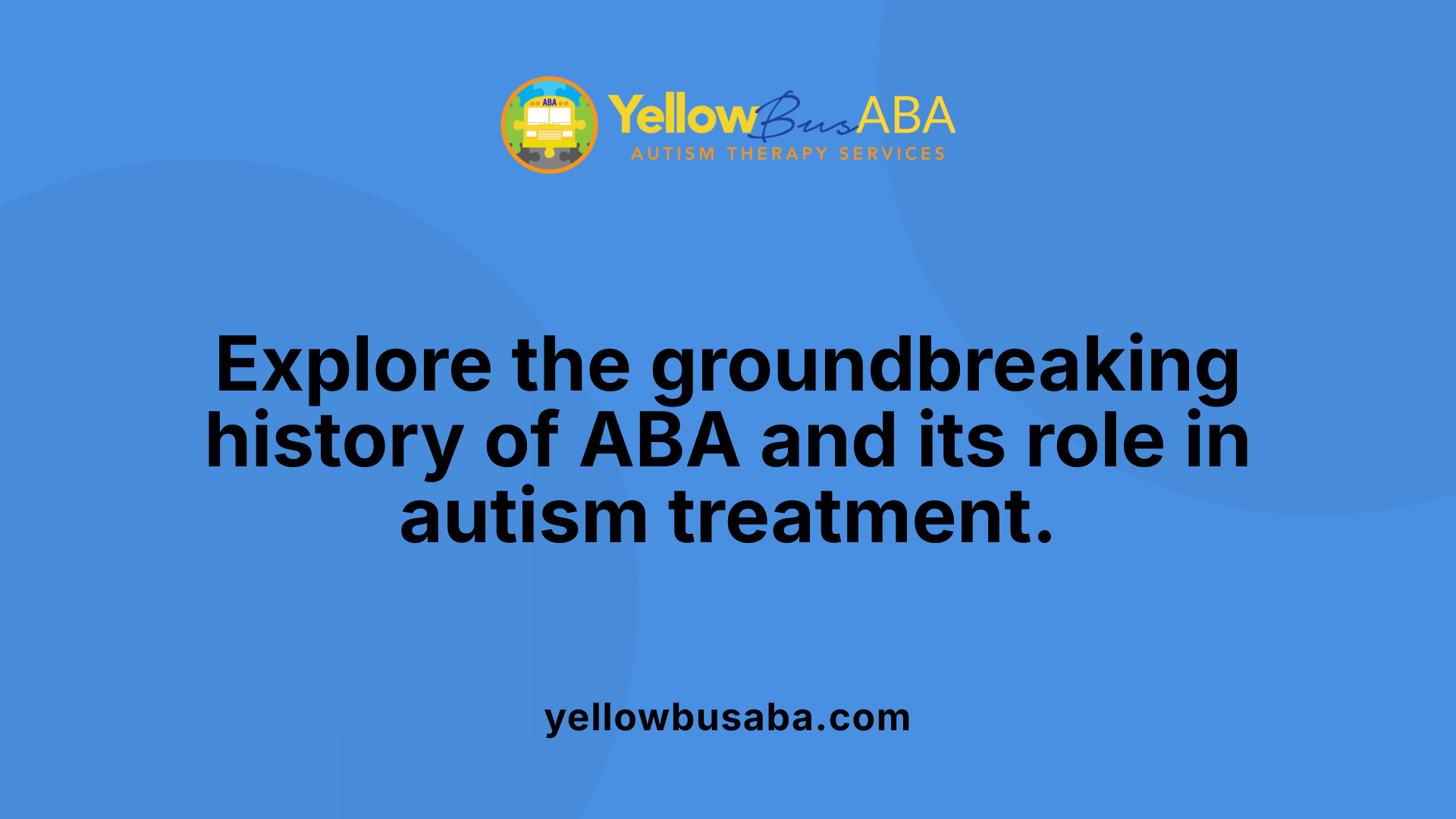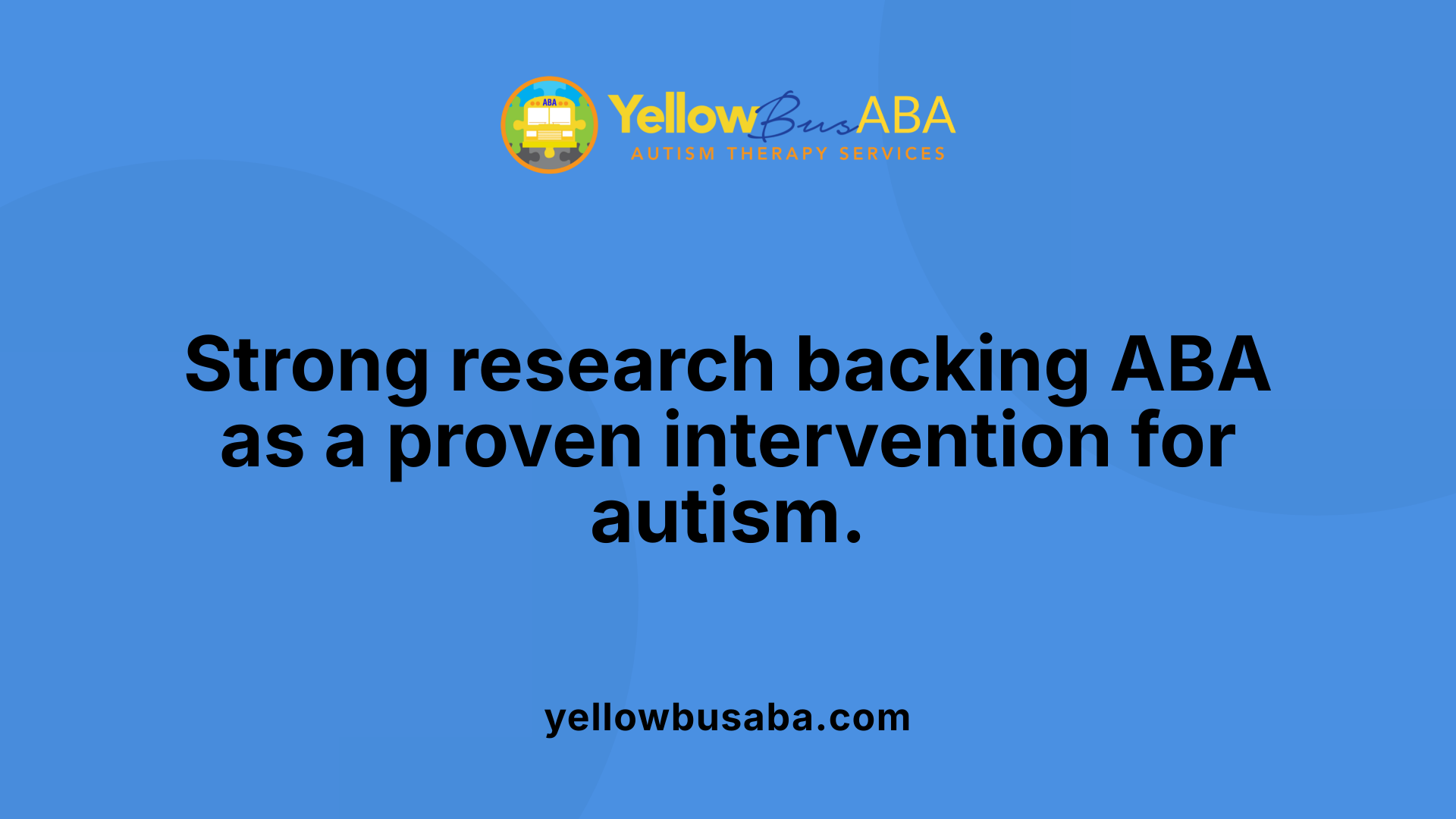The Long-Term Impact of Quality ABA Therapy
November 12, 2025
Unlocking Lifelong Benefits Through Applied Behavior Analysis

Introduction to ABA Therapy and Its Historical Roots
Applied Behavior Analysis (ABA) therapy is a well-established, science-based approach widely used to support individuals with autism spectrum disorder (ASD). Stemming from core behavioral science concepts developed by B.F. Skinner and others, ABA focuses on understanding and shaping behavior through environmental influences. Since its pioneering application to autism in the 1960s and landmark research by Ivar Lovaas in the 1980s, ABA has evolved to become a cornerstone of autism treatment with a growing body of evidence supporting its long-term impact on communication, social skills, and independence.
What is ABA Therapy and How Does It Work?

What is Applied Behavior Analysis (ABA) therapy?
Applied Behavior Analysis (ABA) therapy is a science-based method focused on understanding and changing behavior by analyzing the relationship between environment and actions. It works by examining antecedents (what happens before a behavior), the behavior itself, and consequences following the behavior — commonly abbreviated as the ABCs. ABA encourages development of positive, socially important skills such as communication, social interactions, and independence.
Techniques used in ABA
ABA therapy employs a variety of strategies tailored to an individual's unique needs. Common techniques include:
- Positive reinforcement: Rewarding desired behaviors to increase their likelihood.
- Discrete trial training: Teaching skills in small, structured steps.
- Pivotal Response Treatment: A naturalistic method focusing on motivation and response to multiple cues.
- Shaping and prompting: Gradually encouraging new behaviors by reinforcing successive approximations.
These methods are applied intensively, often involving 25 to 40 hours per week, and adjusted according to developmental stages and goals.
Personalization and settings for delivery
ABA therapy is highly customizable and can be delivered in various environments like homes, schools, and community centers. Treatment plans are based on thorough assessments by qualified behavior analysts, making therapy relevant to each person's developmental needs. Early diagnosis and intervention, ideally before age five, optimize outcomes through focus on social, linguistic, cognitive, and physical skill development.
Recognition by major health organizations
ABA is officially recognized as an evidence-based best practice for autism treatment by leading bodies including the US Surgeon General and the American Psychological Association. Research spanning over 40 years supports its effectiveness in improving intellectual function, social skills, communication, and daily living capabilities for individuals with ASD and related developmental conditions.
The Historical Evolution and Pioneering Research of ABA in Autism

Origins of ABA based on operant conditioning
Applied Behavior Analysis (ABA) traces its roots to behaviorism studied by B.F. Skinner and others, focusing on operant conditioning principles. This involves modifying behavior through reinforcement and punishment, laying a scientific foundation for behavior modification techniques.
Ivar Lovaas's seminal 1987 study
A groundbreaking moment in ABA's history was O. Ivar Lovaas's 1987 publication, which demonstrated that intensive ABA therapy could effectively improve outcomes for children with autism spectrum disorder (ASD). His study involved approximately 40 hours per week of ABA treatment.
Significant outcomes of early ABA research
Lovaas’s study revealed significant developmental gains, including the emergence of spoken language and an average IQ improvement of about 30 points among treated children. Remarkably, about 90% of children showed significant benefits, with nearly half attaining behavioral levels comparable to their typically developing peers.
Follow-up studies demonstrating sustained gains
A 1993 follow-up reinforced these findings by showing that some children maintained the improvements years after the initial intervention. These results underscored ABA’s potential for producing lasting positive outcomes in communication, cognition, and social functioning for children with ASD.
Clinical Evidence Supporting the Effectiveness of ABA Therapy

What evidence supports the effectiveness of ABA therapy for autism?
Numerous studies over the past four decades demonstrate that Applied Behavior Analysis (ABA) therapy effectively improves social, communication, and cognitive skills in individuals with autism spectrum disorder (ASD). Pioneering research by Dr. Ivar Lovaas in 1987 found that intensive ABA—around 40 hours per week—resulted in notable IQ gains of approximately 30 points and development of spoken language in children with ASD. Follow-up studies showed some children attaining behavioral levels indistinguishable from their peers.
Multiple meta-analyses and long-term studies further confirm these positive outcomes. Research involving over 20 studies suggests that 85-95% of children undergoing long-term ABA therapy experience significant improvements in intellectual functioning, language, daily living, and social skills. Effect sizes around 0.74 support meaningful enhancements in language and cognitive abilities.
Besides efficacy, major health authorities endorse ABA therapy. The U.S. Surgeon General and the American Psychological Association recognize it as an evidence-based best practice for autism treatment. This strong clinical consensus is anchored by thousands of published research reports showing consistent benefits in socialization, communication, and adaptive behavior when ABA is administered intensively and personalized to individual needs.
In summary, the clinical evidence from rigorous research designs including randomized trials and systematic reviews firmly supports ABA as a leading and effective autism intervention, capable of delivering measurable and lasting developmental gains.
How ABA Therapy Helps Individuals with Autism Achieve Meaningful Gains

Skill areas improved by ABA therapy
ABA therapy improves numerous skill areas essential for individuals with autism. It focuses on enhancing social skills, communication abilities including speech and expressive language, adaptive behaviors such as daily living and self-care, and cognitive functioning. Improvements in understanding social cues and interacting effectively with others are common outcomes.
Role of personalized programs
Personalized ABA therapy programs are crucial due to the heterogeneity of autism spectrum disorder (ASD). Tailoring interventions to an individual's unique strengths, challenges, and developmental stage helps maximize outcomes. Programs incorporate individualized goals and may combine ABA with other developmental models, ensuring a comprehensive, child-focused approach.
Typical weekly intensity and therapy duration
Effective ABA therapy often involves intensive intervention ranging from 25 to 40 hours per week, sustained over one to three years or more. Early start, typically before age five, enhances developmental gains. Such long-term, consistent treatment supports lasting improvements in intellectual functioning and social integration.
Description of common ABA techniques
Several widely used ABA techniques include:
- Discrete Trial Training (DTT): Breaks skills into small, manageable steps using clear instructions and reinforcement.
- Early Start Denver Model (ESDM): Combines ABA principles with developmental and relationship-based approaches targeting young children.
- Pivotal Response Training (PRT): Focuses on pivotal areas like motivation and self-management to induce widespread improvements.
- Early Intensive Behavioral Intervention (EIBI): An intensive form targeting multiple skill domains to accelerate development.
Together, these methods employ structured learning and positive reinforcement to cultivate essential skills in various settings.
Overall, ABA therapy uses evidence-based behavioral strategies tailored to individual needs, helping individuals with autism build foundational and advanced skills for a more independent and improved quality of life.
Who Provides ABA Therapy and What Happens During a Session?
Qualifications and Certification of ABA Therapists
ABA therapy is delivered by professionals with specialized training in behavioral analysis. The most recognized providers are Board Certified Behavior Analysts (BCBAs) and therapists holding licenses aligned with their state regulations. These individuals generally hold at least a master's degree in psychology, education, or related fields. Certification requires completing between 1,500 and 2,000 hours of supervised practice and passing stringent exams to ensure proficiency in ABA principles.
Roles of BCBAs and Licensed Therapists
BCBAs design individualized treatment plans and oversee therapy progress. They train and supervise therapists who implement these plans during sessions. Licensed therapists carry out the direct interventions with clients, applying data-driven methods tailored to each child's needs. These roles work collaboratively with families and other professionals to enhance overall care quality.
Structure of a Typical ABA Therapy Session
Sessions typically feature one-on-one engagements where therapists use structured tasks targeting communication, social skills, or behavior modification. Initial phases may include play-based warm-ups to foster comfort and motivation. Throughout, therapists apply positive reinforcement to encourage learning, collecting detailed data to evaluate outcomes and inform future goals. Sessions are adapted dynamically based on ongoing evaluations.
The Importance of Family Involvement and Ongoing Monitoring
Family participation is critical for generalizing skills outside therapy settings. Therapists often train parents to support interventions at home. Regular monitoring helps adjust therapy intensity and targets, ensuring progress aligns with developmental milestones. Consistent scheduling and feedback loops maintain momentum and maximize the therapy's benefits.
Together, these elements create a comprehensive and evolving support system driven by qualified professionals working collaboratively with families to promote meaningful improvements for children with autism.
Contemporary Trends: Personalization, Integration, and Challenges
Shift towards Personalized and Hybrid Treatments
In recent years, there has been a notable shift away from intensive ABA as the sole intervention for autism spectrum disorder (ASD). The evolving understanding of ASD's heterogeneous nature has highlighted the limitations of a one-size-fits-all approach, prompting clinicians and researchers to embrace more personalized and hybrid treatment strategies. These approaches combine ABA with other therapeutic models tailored to the individual needs of each child.
Limitations of Intensive ABA Alone
While intensive ABA (typically 25 to 40 hours per week) has demonstrated significant benefits in improving language, social skills, and cognitive functioning, its limitations are becoming apparent. Systematic reviews reveal mixed results in areas like receptive language, adaptive behavior, and overall cognition. The demanding intensity and prolonged duration sometimes present barriers to accessibility and do not address all developmental domains effectively.
Examples of Other Treatment Models
Newer models such as naturalistic developmental behavioral interventions (NDBIs) have gained attention. These models emphasize learning in natural settings and focus on social engagement and developmental readiness, offering a more flexible and child-led approach compared to structured ABA. Parent training and individualized care plans further support personalized treatment, enabling families to participate actively in intervention strategies. Organizations like Catalight exemplify this inclusive approach by providing varied therapies alongside ABA.
Efforts to Improve Accessibility and Tailor Interventions
Modern clinical practices increasingly focus on reducing costs and improving access to autism treatments. Tailoring interventions to fit individual developmental profiles and family circumstances has become a priority. Evidence-based methods are being integrated across diverse settings—from homes to community centers—to maximize benefit while minimizing barriers. This multipronged approach aims to offer equitable, effective support for all children with ASD, helping them achieve better outcomes and enhancing quality of life.
The Long-Term Impact of Quality ABA Therapy on Individuals and Families

Sustained developmental gains over years
ABA therapy has demonstrated lasting positive effects in individuals with autism. Landmark studies dating back to Ivar Lovaas's 1987 research showed that intensive ABA treatment—typically 25 to 40 hours per week—led to significant gains in speech, IQ, and social behavior. Follow-up studies in 1993 noted that many children retained their developmental progress long-term, with some children appearing indistinguishable from neurotypical peers.
Improvements in independence and social integration
Beyond cognitive gains, ABA therapy fosters enhanced independence by targeting life skills such as self-care, vocational activities, and social functioning. Tailored interventions help individuals better understand social cues, communicate effectively, and engage in community life. These advantages support improved societal integration, allowing individuals to lead more autonomous and productive lives.
Impact on quality of life and family dynamics
The beneficial effects of ABA extend to family well-being. As children develop stronger social and adaptive skills, family stress often decreases, and daily routines improve. Families report greater satisfaction due to increased independence of their children and enhanced participation in typical social environments. Long-term ABA therapy thus contributes to improved quality of life for both individuals with autism and their families.
Considerations drawn from longitudinal studies and meta-analyses
Multiple longitudinal studies and meta-analyses corroborate the long-term benefits of ABA, highlighting improvements in intellectual function, communication, and daily living skills sustained over years. However, heterogeneous outcomes emphasize the importance of personalized treatment plans that evolve with the individual's developmental needs. The shift toward individualized, hybrid approaches aligns with these findings, ensuring continued effectiveness across diverse cases.
| Aspect | Long-Term Benefits | Source/Details |
|---|---|---|
| Developmental Gains | Sustained IQ and speech improvements | Lovaas 1987, 1993 follow-ups |
| Independence and Social Function | Enhanced daily living and social integration | Multiple longitudinal studies |
| Family Dynamics | Reduced caregiving stress, better family quality of life | Clinical reports and family feedback |
| Personalized Approaches | Tailored plans improve outcomes | Meta-analyses, current best practices |
Together, these findings underscore that quality, intensive ABA therapy offers substantial long-term benefits, improving not only developmental outcomes but also enriching family life and community participation.
Conclusion: A Promising Path Forward with Quality ABA Therapy
Quality Applied Behavior Analysis therapy, grounded in decades of rigorous scientific research, has demonstrated significant and lasting improvements in communication, social skills, and independence for individuals with autism spectrum disorder. Its evidence-based, individualized approach allows for meaningful developmental gains that can transform lives and enhance family quality of life. While evolving perspectives encourage integration with other personalized interventions, ABA remains a foundational pillar of autism treatment recognized by leading health authorities. Continued research and innovation will help optimize its long-term impact, ensuring accessibility and tailored care for diverse needs, and fostering greater inclusion and opportunity for individuals with autism.
References
- Applied Behavior Analysis and Modern Autism Care
- Does ABA therapy work for children with autism?
- Mental health outcomes associated with applied behavior ...
- The Power of Applied Behavior Analysis Therapy
- What to Expect on the First Day of ABA Therapy?
- From Minutes to Months: The Timeline of ABA Therapy
- The effectiveness of applied behavior analysis program ...






